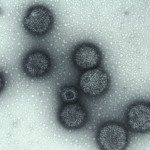Link to Pubmed [PMID] – 17704267
Appl. Environ. Microbiol. 2007 Oct;73(20):6601-11
Robust genotyping methods for Lactobacillus casei are needed for strain tracking and collection management, as well as for population biology research. A collection of 52 strains initially labeled L. casei or Lactobacillus paracasei was first subjected to rplB gene sequencing together with reference strains of Lactobacillus zeae, Lactobacillus rhamnosus, and other species. Phylogenetic analysis showed that all 52 strains belonged to a single compact L. casei-L. paracasei sequence cluster, together with strain CIP107868 (= ATCC 334) but clearly distinct from L. rhamnosus and from a cluster with L. zeae and CIP103137(T) (= ATCC 393(T)). The strains were genotyped using amplified fragment length polymorphism, multilocus sequence typing based on internal portions of the seven housekeeping genes fusA, ileS, lepA, leuS, pyrG, recA, and recG, and tandem repeat variation (multilocus variable-number tandem repeats analysis [MLVA] using nine loci). Very high concordance was found between the three methods. Although amounts of nucleotide variation were low for the seven genes (pi ranging from 0.0038 to 0.0109), 3 to 12 alleles were distinguished, resulting in 31 sequence types. One sequence type (ST1) was frequent (17 strains), but most others were represented by a single strain. Attempts to subtype ST1 strains by MLVA, ribotyping, clustered regularly interspaced short palindromic repeat characterization, and single nucleotide repeat variation were unsuccessful. We found clear evidence for homologous recombination during the diversification of L. casei clones, including a putative intragenic import of DNA into one strain. Nucleotides were estimated to change four times more frequently by recombination than by mutation. However, statistical congruence between individual gene trees was retained, indicating that recombination is not frequent enough to disrupt the phylogenetic signal. The developed multilocus sequence typing scheme should be useful for future studies of L. casei strain diversity and evolution.



